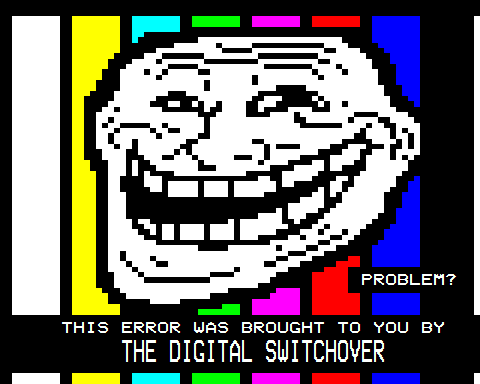- Number entry system. The number entry page navigation system is a method relatively unique to the format, though it borrows from book/magazine page numbering. Similarities can also be drawn with automated telephone call centres which are navigated by entering numbers on the telephone keypad. Indeed, this is how Viewdata works.
- Fastext is more like web browser functions and is closely related to the hyperlinking system, with a one-press/click labelled link navigating directly to the desired page. It is, in most cases, also quicker than internet linking, depending on the internet connection speed.
- Page Up/Down function is commonly used to scroll through the data on teletext. Can be compared to web browser scroll bars.
- Subpages. Due to shortage of space on individual pages, teletext services utilise subpages to transmit larger amounts of information. One teletext page can on average fit around 60 words in three line-separated paragraphs. This can be compared with mobile phone browsers which also have varying space restrictions and sometimes use subpages to transmit text.
- Hold function is a necessity with the automatic subpage scrolling on teletext. Can be linked with VCR/DVD pause buttons as well as the 'pause live TV' function on modern TV set top boxes. Apart from this, it's not really used that often in other media.
- Reveal Function. Javascript can be used to replicate the reveal function on the web browser to reveal some hidden information, e.g. pop up and drop down menus.
- Mix/in-vision function. A lot of the new interactive TV services provide a small television screen alongside the text information. Not the same as the old in-vision version though, as there is currently no function for 'sport boxes' and in-vision videprinters to be relayed over the top of the television picture. For the football, this has largely been overtaken by the interactive score service and for the cricket interactive scorecards are sometimes available.
- Current GMT date and time. A lot of modern set top boxes now have exact GMT time settings, but some still do not - the user has to manually input the time. Same goes for computers. There are wall clocks that have a built in signal received from Greenwich to synchronise their reading with the exact GMT.
- Random page function. On some controllers there is the option to flick to a random teletext page. This is related to the 'I'm Feeling Lucky' button at google.com and more closely the wiki 'view random page' function.
- Alarm clock. This function has been applied to all sorts of formats from video recorders to mobile phones to computers. The teletext version is no longer available but there used to be a page specially for it on a number of teletext services.
Monday, 22 October 2007
Teletext functionalities
Teletext is navigated using a remote control. The format has many functionalities for getting around the numerous electronic pages held on the teletext database. These are all related to navigation methods on other information retrieval services.
Subscribe to:
Post Comments (Atom)



0 comments:
Post a Comment